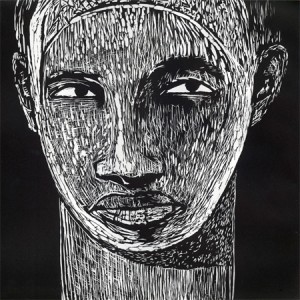 A recent addition to the permanent collection, I See You (2005), created and gifted to the Williamson Gallery by Scripps Professor Emerita Dr. Samella Lewis, is characteristic of the artist’s work. The anonymous androgynous face has a chiseled, linear quality that is the result of the linocut technique that Dr. Lewis uses. Linocut is a variant of woodcut that requires a sheet of linoleum as the relief surface: a design is cut into the surface of the linoleum producing an inverted image of the final print product; the surface is inked, then pressed onto paper or fabric. Dr. Lewis uses linocut to create images within a Black aesthetic that she has spent the past 30 years cultivating and proliferating.
A recent addition to the permanent collection, I See You (2005), created and gifted to the Williamson Gallery by Scripps Professor Emerita Dr. Samella Lewis, is characteristic of the artist’s work. The anonymous androgynous face has a chiseled, linear quality that is the result of the linocut technique that Dr. Lewis uses. Linocut is a variant of woodcut that requires a sheet of linoleum as the relief surface: a design is cut into the surface of the linoleum producing an inverted image of the final print product; the surface is inked, then pressed onto paper or fabric. Dr. Lewis uses linocut to create images within a Black aesthetic that she has spent the past 30 years cultivating and proliferating.
The face in I See You is backed by solid black and defined in white. If one observes the image from a short distance, a stark black/white dichotomy is evident (look, for example, at the whites of the figure’s eyes), but when one looks from farther away, the lines blur, and the face appears to be in grayscale. Considered in light of Dr. Lewis’s trailblazing work as a Black artist, this phenomenon might be interpreted as a commentary on race relations in the 21st century.
I See You is an example of Dr. Lewis’s fine artistry, for which she is well known. She is also recognized and perhaps has earned greater renown for her work as an educator and art historian. Her academic career began at Dillard University, where she met her mentor, Elizabeth Catlett, another outstanding African American artist. After completing her undergraduate studies at the Hampton Institute, Dr. Lewis earned a master’s and doctorate degree in art history from Ohio State University. While writing her dissertation, she began teaching as an associate professor at Morgan State College in 1950. She traveled to Taiwan with a Fulbright Fellowship, and upon her return she became a post-doctoral fellow at the University of Southern California.
Dr. Lewis spent the next two decades in Los Angeles, acting as a significant force in the art scene there and in the rest of the country. In 1969, she became the education coordinator at the Los Angeles County Museum of Art and was also appointed Professor of Art History and Humanities at Scripps. She was the first tenured African American faculty member at Scripps, and while teaching at the college she directed and curated exhibitions for the Clark Humanities Museum. Among the students with whom she worked closely at Scripps was the now internationally recognized Black artist Alison Saar. Also during her tenure at Scripps, Dr. Lewis created the Ashanti Gallery in Pomona, California.
From Los Angeles, Dr. Lewis was incredibly influential in the establishment and development of Black art as an art historical genre. In the 1960s, she made several short documentaries highlighting the careers of African American artists such as John Outterbridge, Bernie Case and Richmond Barthé. In 1969,she published a two-volume illustrated guide to contemporary African American artists comprised of artist statements and images. In 1976, she founded the International Review of African-American Art, which continues to be the scholarly journal on Black art. Then, in 1978, Dr. Lewis published Art: African American, the first textbook documenting the history of African American art. She was responsible for the founding of the Museum of African American Art in Los Angeles.
Dr. Lewis taught at Scripps until 1984, and she has continued to write, curate, and create since then. In 2002, the Samella Lewis Scholarship was established at Scripps for African American students based on scholastic achievement, excellence in character, leadership, and responsibility. In 2007, Scripps launched the Samella Lewis Contemporary Art Collection with the assistance and in honor of Dr. Lewis. The collection focuses on contemporary artists, with a special emphasis on art by women and African American artists.
Reference
- Johnson, Eloise. Places & Faces: Samella Lewis. Stella Jones Gallery: New Orleans, LA. 2007
Written by Zoe Larkins (SC ’09), Summer 2008 Wilson Intern.

